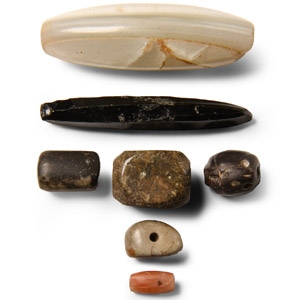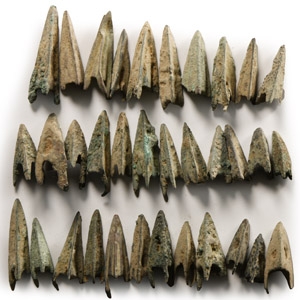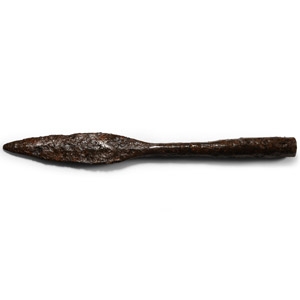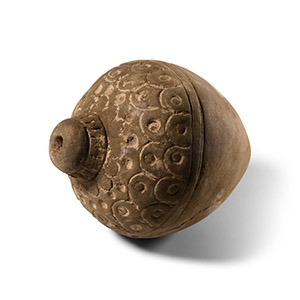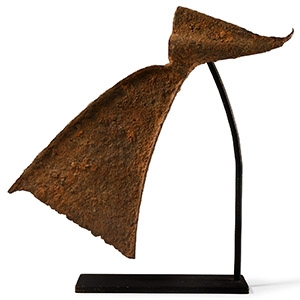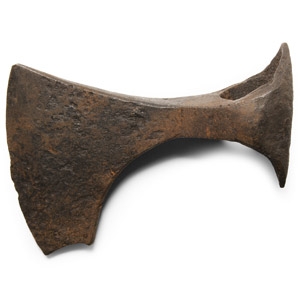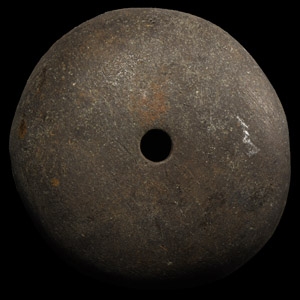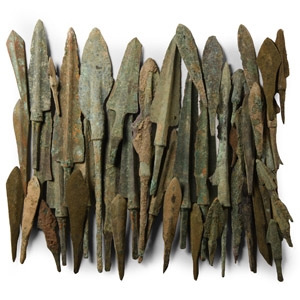Home > Auctions > 4 June - 8 June 2024
Ancient Art, Antiquities, Natural History & Coins
Auction Highlights:
Ex Simmons gallery, 1990s.
From a North London, UK, collection.
UK gallery, early 2000s.
Cf. Hussein, M.M., Altaweel, M., Gibson, McGuire, Nimrud The Queen’s Tombs, Baghdad-Chicago, 2016, pl.164, lett.b, for a similar bead necklaces made of a mixture of stones, glass and shell.
Similar beads were found during the excavations of the royal tombs of Nimrud. Thousands of beads were discovered in the sarcophagi, including those of Nimrud’s Queens; they probably originally formed part of wide collars with multiple strands.
Acquired 1980-2015.
Ex Abelita family collection.
Found near Wetwang, East Yorkshire, UK.
Acquired circa 2005.
Ian Wilkinson collection, Nottinghamshire, UK.
Cf. Swanton, M.J. Spearheads of the Anglo-Saxon Settlements, London, 1973, fig.18(d).
A small number of leaf-shaped blades measuring between some 16 and 28 cm in length are similar to the smaller leaf-shaped pieces of the Swanton series C, except that they tend to be more slender overall. The socket is always narrowly split up its entire length.
From a specialist collection of militaria, London, UK, collected 1990s onwards.
Accompanied by an academic paper by military specialist Dr Raffaele D'Amato, dated 15 July 2019 and titled 'Eastern Roman Empire - Greek Fire Bomb or Hand Grenade (μεσαίον kακάβιον) 9th-11th century AD'.
Cf. Arendt, W. I., Granaten des 13-14. Jahrhunderts, die an der Wolga gefunden sind, Zeitschrift fur Historische Waffen-und Kostumkunde, 11 (1926-8), p.42; cf. Arendt, W., Die Spharisch-konischen Gefäße aus Gebranntem Ton, ibid; cf. Ayalon, D., Gunpowder and Firearms in the Mamluk Kingdom, London, 1956, p.16.
Apart from the use of siphons or manual flame-throwers called cheirosiphona, special corps of Roman soldiers employed terracotta grenades, in the form of small jars, abundantly evidenced in archaeological excavations. They were called μεσαία kακαβιά or κυτροκακάβια where the former had a bulbous shape and the latter a more cylindrical form.
Acquired 1980-2015.
Ex Abelita family collection.
From a collection acquired on the UK art market from various auction houses and collections mostly before 2000.
From an important Cambridgeshire estate; thence by descent.
Found near Wetwang, East Yorkshire, UK.
Acquired circa 2005.
Ian Wilkinson collection, Nottinghamshire, UK.
Cf. Swanton, M.J. Spearheads of the Anglo-Saxon Settlements, London, 1973, fig.47.
Exhibited at Harwich Museum, Harwich, Essex, UK, 14th March-9th June 2024; accompanied by a copy of a photograph of the artefact on display.
The spear-heads of group I2 belong to a larger number of blades with more slender and regularly curved leaf-shapes than previous types. The majority present profiles more regularly curved from junction to tip, the broader part of the blade near the middle, with the fuller comformably longer. All of the group are much of the length varying between some 25 and 35 cm.
From the collection of a Californian, USA, gentleman, dating back to the late 1960s.
Cf. Sedov, B.B., Finno-Ugri i Balti v Epokhi Srednevekovija, Moscow, 1987, pl.CXXIV, item 4, for identical type.
The Curonians were known as fierce warriors and sailors who were involved in several wars and alliances with the Swedish, Danish and Icelandic Vikings. Baltic tribes created an original and impressive set of weaponry. They included battle knives, battle axes and spears and javelins with medium sized heads of a characteristic shape.
From the private collection of a London gentleman, from his grandfather's collection formed before the early 1970s.
Cf. Arbman, H., Birka I: Die Gräber, Uppsala, 1940, grave 735, for type.
Reputed to have been excavated near Viables in Hampshire at the end of the 19th century.
From the estate of the late Jennifer Simmonds.
Acquired from Jacobs & Hunt auctioneers, Petersfield, Hampshire, UK.
See Marsden, E.A., Greek and Roman Artillery. Historical Development, Oxford, 1969, for discussion; cf.Russo, F., Tormenta, Venti secoli di Artiglieria Meccanica,, Roma, 2002, p.209, fig.51, for the frontal sculpture of a catapult of 1st century A.D. preserved in the Vaticani Musei, fitted with similar bosses.
The circular umbo does not correspond to any known central shield boss, as it also lacks the lower edge; instead, it finds a good correspondence with the circular bosses that reinforced the lower and upper frame of a catapult, equipped with a central bronze cover.
Acquired 1980-2015.
Ex Abelita family collection.
1129 - 1140 of 2809 LOTS

.jpg)

.jpg)
.jpg)
.jpg)
